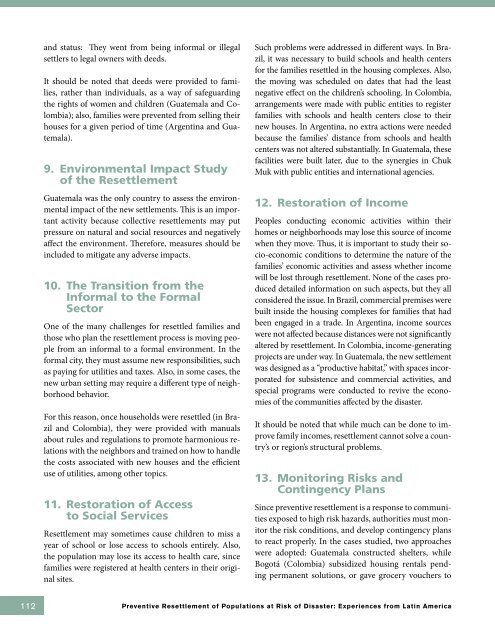Preventive Resettlement of Populations at Risk of Disaster - GFDRR
Preventive Resettlement of Populations at Risk of Disaster - GFDRR
Preventive Resettlement of Populations at Risk of Disaster - GFDRR
You also want an ePaper? Increase the reach of your titles
YUMPU automatically turns print PDFs into web optimized ePapers that Google loves.
and st<strong>at</strong>us: They went from being informal or illegal<br />
settlers to legal owners with deeds.<br />
It should be noted th<strong>at</strong> deeds were provided to families,<br />
r<strong>at</strong>her than individuals, as a way <strong>of</strong> safeguarding<br />
the rights <strong>of</strong> women and children (Gu<strong>at</strong>emala and Colombia);<br />
also, families were prevented from selling their<br />
houses for a given period <strong>of</strong> time (Argentina and Gu<strong>at</strong>emala).<br />
9. Environmental Impact Study<br />
<strong>of</strong> the <strong>Resettlement</strong><br />
Gu<strong>at</strong>emala was the only country to assess the environmental<br />
impact <strong>of</strong> the new settlements. This is an important<br />
activity because collective resettlements may put<br />
pressure on n<strong>at</strong>ural and social resources and neg<strong>at</strong>ively<br />
affect the environment. Therefore, measures should be<br />
included to mitig<strong>at</strong>e any adverse impacts.<br />
10. The Transition from the<br />
Informal to the Formal<br />
Sector<br />
One <strong>of</strong> the many challenges for resettled families and<br />
those who plan the resettlement process is moving people<br />
from an informal to a formal environment. In the<br />
formal city, they must assume new responsibilities, such<br />
as paying for utilities and taxes. Also, in some cases, the<br />
new urban setting may require a different type <strong>of</strong> neighborhood<br />
behavior.<br />
For this reason, once households were resettled (in Brazil<br />
and Colombia), they were provided with manuals<br />
about rules and regul<strong>at</strong>ions to promote harmonious rel<strong>at</strong>ions<br />
with the neighbors and trained on how to handle<br />
the costs associ<strong>at</strong>ed with new houses and the efficient<br />
use <strong>of</strong> utilities, among other topics.<br />
11. Restor<strong>at</strong>ion <strong>of</strong> Access<br />
to Social Services<br />
<strong>Resettlement</strong> may sometimes cause children to miss a<br />
year <strong>of</strong> school or lose access to schools entirely. Also,<br />
the popul<strong>at</strong>ion may lose its access to health care, since<br />
families were registered <strong>at</strong> health centers in their original<br />
sites.<br />
Such problems were addressed in different ways. In Brazil,<br />
it was necessary to build schools and health centers<br />
for the families resettled in the housing complexes. Also,<br />
the moving was scheduled on d<strong>at</strong>es th<strong>at</strong> had the least<br />
neg<strong>at</strong>ive effect on the children’s schooling. In Colombia,<br />
arrangements were made with public entities to register<br />
families with schools and health centers close to their<br />
new houses. In Argentina, no extra actions were needed<br />
because the families’ distance from schools and health<br />
centers was not altered substantially. In Gu<strong>at</strong>emala, these<br />
facilities were built l<strong>at</strong>er, due to the synergies in Chuk<br />
Muk with public entities and intern<strong>at</strong>ional agencies.<br />
12. Restor<strong>at</strong>ion <strong>of</strong> Income<br />
Peoples conducting economic activities within their<br />
homes or neighborhoods may lose this source <strong>of</strong> income<br />
when they move. Thus, it is important to study their socio-economic<br />
conditions to determine the n<strong>at</strong>ure <strong>of</strong> the<br />
families’ economic activities and assess whether income<br />
will be lost through resettlement. None <strong>of</strong> the cases produced<br />
detailed inform<strong>at</strong>ion on such aspects, but they all<br />
considered the issue. In Brazil, commercial premises were<br />
built inside the housing complexes for families th<strong>at</strong> had<br />
been engaged in a trade. In Argentina, income sources<br />
were not affected because distances were not significantly<br />
altered by resettlement. In Colombia, income-gener<strong>at</strong>ing<br />
projects are under way. In Gu<strong>at</strong>emala, the new settlement<br />
was designed as a “productive habit<strong>at</strong>,” with spaces incorpor<strong>at</strong>ed<br />
for subsistence and commercial activities, and<br />
special programs were conducted to revive the economies<br />
<strong>of</strong> the communities affected by the disaster.<br />
It should be noted th<strong>at</strong> while much can be done to improve<br />
family incomes, resettlement cannot solve a country’s<br />
or region’s structural problems.<br />
13. Monitoring <strong>Risk</strong>s and<br />
Contingency Plans<br />
Since preventive resettlement is a response to communities<br />
exposed to high risk hazards, authorities must monitor<br />
the risk conditions, and develop contingency plans<br />
to react properly. In the cases studied, two approaches<br />
were adopted: Gu<strong>at</strong>emala constructed shelters, while<br />
Bogotá (Colombia) subsidized housing rentals pending<br />
permanent solutions, or gave grocery vouchers to<br />
112 <strong>Preventive</strong> <strong>Resettlement</strong> <strong>of</strong> <strong>Popul<strong>at</strong>ions</strong> <strong>at</strong> <strong>Risk</strong> <strong>of</strong> <strong>Disaster</strong>: Experiences from L<strong>at</strong>in America
















